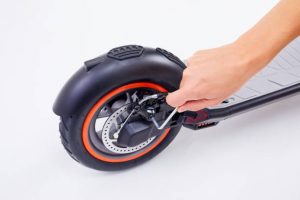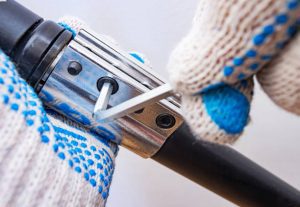We’ve all been there – that moment when we’re zooming around on our scooters, and suddenly, the steering goes awry. It’s scary, unnerving, and downright unsafe. That’s why it’s crucial to understand the role of pro scooter forks.
As the unsung hero of your ride, it’s often overlooked until something goes wrong. Here at FamilyHype, we want to make sure that everyone has a safe and enjoyable ride with their loved ones, so we’re here to shine a light on this essential component so you can achieve that perfect balance and control while cruising down the street or performing tricks at the park.

With our help, you’ll be able to enjoy a smooth ride and gain more control over your scooter, allowing you to take your tricks to the next level. We hope you share your feedback and experiences with us and can enjoy the ultimate steering perfection with the help of your scooter forks!
Understanding The Function Of A Scooter Fork
You can’t underestimate the role of a scooter fork. It’s not just about steering but truly mastering control and balance. We’ve discovered the fork material importance in maintaining a smooth ride. Scooter Fork Innovations have certainly improved our experience on two wheels. Remember, understanding your scooter right down to its forks helps you serve others better with informed advice.
A scooter fork serves as a pivotal component that plays a vital role in the steering and stability of a kick scooter. Built or positioned at the front of the scooter, the fork’s primary function is to securely hold the front wheel in place while allowing it to pivot smoothly for steering.
The fork’s design and construction influence the scooter’s maneuverability, responsiveness, and overall riding experience. It connects the front wheel to the scooter’s deck and handlebars, facilitating controlled turns, stability, and navigation.
As a fundamental part of the scooter’s mechanics, the fork’s proper function is integral to ensuring safe and enjoyable rides.
Types Of Scooter Forks
Let’s dive right into the different types of two-wheeler front suspensions, folks! We’ve witnessed some impressive fork innovations in recent years, each kind with its own strengths.
There are two main types of forks: threaded and threadless. Additionally, within the category of threadless forks, there are variations based on the type of compression system they are compatible with. Here’s an overview of these types:
Threaded Forks: Threaded forks are designed to work with threaded headset systems. They have a threaded shaft that extends through the headset and connects to the stem. These forks are secured in place by a large nut that threads onto the fork shaft, pressing against the headset cups to hold the fork in position.

Threadless Forks: Threadless forks are designed for use with threadless headset systems, which are more common in modern pro scooters. They do not have a threaded shaft like threaded forks. Instead, threadless forks have a smooth shaft that extends through the headset bearings. The stem clamps onto the shaft, securing the fork in place.
Threadless forks further vary based on the type of compression system they are compatible with:
-
- HIC Forks (Hidden Internal Compression): These forks are designed to work with the Hidden Internal Compression system, where a compression bolt is inserted down through the fork and tightened into the top of the headset.
- SCS Forks (Standard Compression System): SCS forks work with the Standard Compression System, utilizing a compression clamp that wraps around both the fork and the handlebars, securing them together.
- IHC Forks (Integrated Headset Compression): IHC forks are designed for the Integrated Headset Compression system, where a compression bolt is threaded directly into the fork’s integrated compression thread.
- ICS Forks (Inverted Compression System): ICS forks are compatible with the Inverted Compression System, which involves a compression bolt being inserted down through the fork and threaded into a special compression bolt that extends above the bar ends.
- Mini HIC Forks: A variation of HIC forks, Mini HIC forks are designed for smaller diameter bars.
Different scooter riders may prefer different types of forks based on their riding style, compatibility with their scooter setup, and personal preferences. It’s essential to ensure that the chosen fork is compatible with the rest of your scooter’s components and the chosen compression system.

How To Choose The Right Fork For Your Scooter
Picking out the ideal front suspension for your two-wheeler can be a real game-changer, and we’re here to guide you through it.
- Understand your needs: Are you a casual rider or an extreme sports enthusiast?
- Fork Material Analysis: Consider strength and weight aspects.
- Scooter Fork Brands: Research reputable brands before buying.
- Match with scooter type: Ensure compatibility.
Next, let’s shift gears to maintaining your scooter fork for optimal performance!
Maintaining Your Scooter Fork
Maintaining your two-wheeler’s front suspension isn’t just about keeping it in tip-top shape; it’s also a fantastic way to ensure those thrilling rides never have to end prematurely. Regular fork adjustments can help increase its durability factors significantly.
Trust us – we’ve been there! A regular check-up might seem tedious, but it will always pay off in the long run. It’s all about helping each other enjoy our scooters safely and fully. Moreover, the following are some important tips you should also consider whether you’re a pro or a beginner.
- Regular Inspection: Conduct regular visual inspections of your scooter fork for signs of damage, wear, or cracks. Look for any bending or misalignment that could affect steering or stability. If you notice any issues, address them promptly to prevent further damage.
- Cleaning and Lubrication: Keep your fork clean from dirt and debris that can accumulate in the headset area. Use a damp cloth to wipe down the pro scooter fork regularly. Applying a light lubricant to the headset bearings can help maintain smooth steering. Lubricating them and the tube will make a big difference in making your ride easier and lighter.
- Tighten Bolts and Nuts: Check and tighten the bolts and nuts that secure the fork to the decks and handlebars. Loose bolts can lead to instability and affect your riding experience. Make sure all connections are secure but avoid over-tightening to prevent damage.
- Maintaining Compression Systems: If your fork is part of a compression system like HIC, SCS, IHC, or ICS, ensure that the compression components are in good condition. Regularly inspect and tighten compression bolts and clamps to prevent any wobbling or slipping of components.
- Replace Worn Parts: If you notice significant wear or damage to your fork, such as worn headset bearings or cracked components, consider replacing those scooter parts. Another part that may need replacement is the grip tape, which is the adhesive layer that covers the deck of your scooter and provides traction and comfort for your feet. If your grip tape is peeling, torn, or faded, you can remove it and apply a new one with a fresh design and texture. Replacing worn or damaged parts promptly will help prevent accidents and ensure the safety of your scooter.
By following these maintenance steps, you can extend the lifespan of your scooter fork and enjoy a safe and smooth riding experience. Regular upkeep will not only enhance your scooter’s performance but also contribute to your overall safety while riding.

Conclusion
We’ve covered a lot on scooter forks, haven’t we? From their function to types and maintenance.
Choosing the right one can be a daunting task, but with help from FamilyHype, you can get the perfect fork for your ride.
Keeping your forks well-maintained is essential for a smooth ride, so make sure to regularly lubricate, tighten, and inspect your forks for any damage.
Additionally, the maintenance of scooter forks involves important actions such as lubricating, tightening, and inspecting for any damage.
With these words in mind, get your knee pads and elbow pads because it’s clear that a smooth ride is worth every effort.
So, take a moment to share your experience and opinions with us, and let us know how you keep your scooter forks in perfect condition!
Frequently Asked Questions (FAQs):
What Is The Fork Of A Scooter?
The fork of a scooter is a component located at the front of the scooter, responsible for holding the front wheel and allowing it to pivot for steering. It connects the front wheel to the deck and handlebars.
What Is The Best Fork For A Scooter?
The best fork for a scooter depends on factors like the rider’s preferences, style of riding, and the scooter’s compatibility. High-quality materials, durability, and compatibility with the wheel size are key considerations when choosing a fork.
What Are The Types Of Scooter Forks?
Scooter forks come in various types, including threaded forks, threadless forks, and compression system forks. Threaded forks require a threaded headset, while threadless forks are compatible with threadless headsets and come in various compression systems like HIC, SCS, and IHC.
What Is The Lightest Scooter Fork?
The lightest forks are often made from lightweight materials like aluminum or titanium. Specific models may vary in weight, so it’s recommended to check with manufacturers or retailers for the latest lightweight fork options.
Why Is It Called A Scooter Fork?
The term “fork” is used because of the component’s resemblance to a fork in its design, with two prongs that hold the front wheel. This terminology is derived from the resemblance to a traditional dining fork.
What Makes A Good Scooter Fork?
A good scooter fork should be made from durable materials, offer compatibility with your scooter’s other components, provide proper clearance for the wheel, and work well with your chosen compression system.
How Many Types Of Forks Are There?
There are generally two main types of forks: threaded forks and threadless forks. Threadless forks can further be categorized based on the type of compression system they are compatible with.
What Is The Lightest Scooter Clamp?
Similar to forks, the lightest scooter clamps are typically made from lightweight materials like aluminum. The specific weight can vary, so it’s advisable to consult product specifications or manufacturers for the lightest clamp options.
Which Brake First On A Scooter?
On a scooter, the brake located on the rear wheel is usually the primary brake. Riders generally use their back foot to engage the brake lever, causing the brake to make contact with the rear wheel and slow down the scooter.
Which Brake First On A Scooter?
The same question appears to be repeated. As mentioned earlier, the rear brake is the primary brake on a scooter, with riders using their back foot to engage the brake lever and slow down the scooter by making contact with the rear wheel.
Last Updated on October 14, 2023 by Cath Aguinaldo
DISCLAIMER (IMPORTANT): This information (including all text, images, audio, or other formats on FamilyHype.com) is not intended to be a substitute for informed professional advice, diagnosis, endorsement or treatment. You should not take any action or avoid taking action without consulting a qualified professional. Always seek the advice of your physician or other qualified health provider with any questions about medical conditions. Do not disregard professional medical advice or delay seeking advice or treatment because of something you have read here a FamilyHype.com.